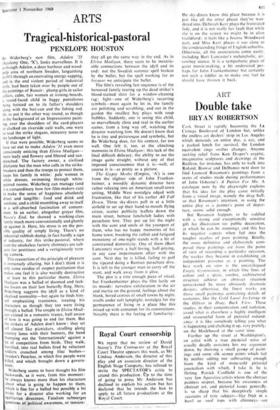ART
Double take
BRYAN ROBERTSON
Cork Street is rapidly becoming the La Cienega Boulevard of London but, unlike the endless art dealers' strip in Los Angeles which demands an entire day, a car, and a packed lunch for survival, the London equivalent rings swifter changes. Anyone seeking relief from Ken Draper's cryptic, imaginative sculptures and drawings at the Redfern, for instance, has only to walk into Roland, Browse and Delbanco next door to find Leonard Rosoman's paintings from a series of studies made during performances of John Osborne's A Patriot For Me. A catalogue note by the playwright explains that his idea for the play came initially from a visual image, namely the drag ball; so that Rosoman's intention, in using the entire play as a painter's point of depar- ture, seems solid enough.
But Rosoman happens to be saddled with a strong and exceptionally sensitive gift for illustration (or public decoration, at which he can be stunning), and this has its negative aspects when fed into the tougher reaches of pure painting. Briefly, the more definitive and elaborately com- posed these paintings are from the point of view of recording a particular occasion, the weaker thcy become in establishing an independent presence as a painting. The best work on view is the uncatalogued Empty Gymnasium, in which fine lines of colour and a spare, sombre, architectural structure achieve an abstract situation unweakcned by more obviously dramatic devices; otherwise, the finest works are those small paintings containing details of costumes, like the Gold Lame Jockstrap or the Officer in Drag. Back View. These studies, in their concentration and isolation, avoid what is elsewhere a highly intelligent and resourceful form of pictorial redund- ancy: it is like somebody telling you what is happening and chalking it up, very prettily, on the blackboard at the same time.
Further up the street at Waddington's, an artist with a true pictorial sense of usually deadly certainty lets my argument down, by showing a small group of paint- ings and some silk screen prints which fail by neither adding nor subtracting enough from the kind of stone-cold pictorial journalism with which, I take it, he is flirting. Patrick Caulfield is one of the very few figurative artists whom the abstract painters respect, because his awareness of abstract art, and pictorial issues generally. is so sharp that his deceptively simple accounts of trite subjects—like fruit in a bowl or roof tops with chimneys—are maded with implications extending far beyond their content. Caulfield is sophisti- cated, to put it mildly, and produces the kind of figurative painting that abstract artists would like to make if they dared.
But this time he has been hoist by his own petard; the show is anyway too thin and small; and though Caulfield has shifted his attack into deep perspective, implied by black contour lines which are both merciless in consistency and subtle in inflexion, not quite enough is added to dislocate the basic cliché. There is, too, a slightly irritating fashionable play with squares and rectangles: the component parts of door- ways, windows, plank roofing and so on: I hope Caulfield continues to resist over- exposure, so far successfully kept at bay, because momentarily the real magic that was in his earliest painting of 1960-4 seems to have evaporated. When Caulfield played around with High Art he arrived at extra- ordinary conclusions; now his target has diminished to pictorial journalism and his conclusions are arrested inside that seduc- tive vacuum, like brightly cropped photos in the glossies.
I cannot discuss the exhibition of paintings and prints by the Canadian, Yves Gaucher, at the Whitechapel, because I instigated the show; although it has since found its own form by properly restricting what was to have been a condensed retro- spective to a group of recent, very severe paintings in a range of greys. But I do urge everyone seriously concerned with intellectual and aesthetic synthesis at a high level not to miss this show. And provided other visitors don't misinterpret your motives, ask to see the paintings with- ut artificial lighting: a necessary evil in an age which looks for showbiz glitter, but ts absence brings unexpected dimensions nto Gaucher's very demanding paintings.















































 Previous page
Previous page